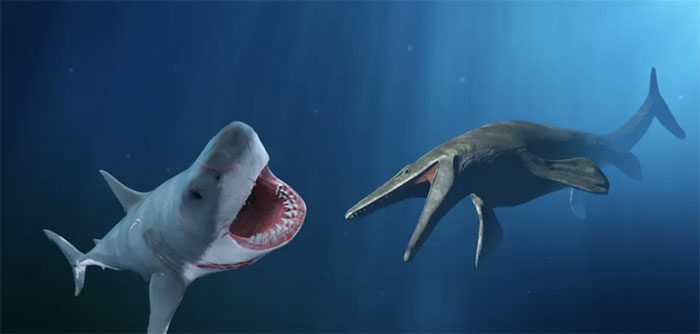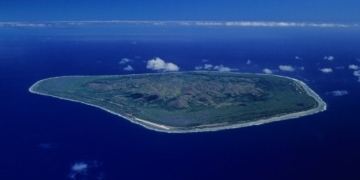The Megalodon shark and the Mosasaurus lizard are both dangerous species. What would happen if there were to be a battle between these two creatures?
Ocean Monsters
Mosasaurus, also known as the “Meuse River Lizard”, became extinct millions of years ago. The Mosasaurus lived from 82 to 66 million years ago during the Cretaceous period. With its elongated body, powerful jaws, and fearsome teeth, the Mosasaurus was undoubtedly a top predator in its ecosystem.
This giant reptile measured between 11 to 17 meters long, inhabiting oceans worldwide but most commonly found in shallow waters around Europe. The Mosasaurus was not capable of diving deep; instead, it preferred to hunt and move to the surface where most of its prey lived.

The giant Megalodon shark faces off against the Mosasaurus. (Photo: FlashMovie/tsuneomp/Dotted Yeti/Shutterstock via IFLScience).
The Mosasaurus had strong fins and a powerful tail, capable of reaching speeds of approximately 48 km/h for short bursts. The “Meuse River Lizard” possessed 40-50 teeth, each measuring about 25-30 mm, capable of generating a bite force of around 3 to 7 tons.
On the opposite side, the giant Megalodon shark dominated the oceans approximately 23 to 3.6 million years ago during the Middle Miocene and Late Miocene epochs.
With an estimated length of up to 18.3 meters and colossal size, the Megalodon is considered one of the largest predatory species to have ever existed.
This species had serrated teeth up to 18 cm long, capable of crushing bones and tearing flesh with a bite force of up to 8 tons.
This ancient shark was a top predator, capable of preying on marine mammals such as whales.
The Megalodon was found all over the world and moved at an average speed of about 4.8 km/h with the ability to burst into rapid speed.
This ocean monster was a massive creature with an estimated weight of around 61.6 tons, equivalent to 10 African elephants or 34 large white elephants.
Who Would Win?
In a hypothetical showdown, the characteristics of these creatures would play a crucial role in determining the outcome. The agility and robust skull structure of the Mosasaurus could provide an advantage in defending against the powerful bites of the Megalodon.
However, the colossal size and terrifying bite force of the Megalodon would make it a formidable opponent if it managed to bite in the right spot.
Moreover, the environment in which the battle takes place is also an important factor to consider. In shallow waters, the heavier and less agile shark would be at a disadvantage compared to the evolved lizard. But the situation would reverse and favor the shark if the battle occurred in deeper waters.
So how can we determine the winner? The Megalodon is an apex predator with no rivals, and nothing poses a threat to it. The Megalodon has more experience facing larger prey, as its diet consisted of marine mammals such as whales.
In contrast, the Mosasaurus developed defensive capabilities to avoid conflicts with other potential threats existing in its time, making it a more cautious “hunter.”
In a hypothetical conflict, the prehistoric shark is likely to have the advantage due to its aggressive nature and incredible biting power.


















































